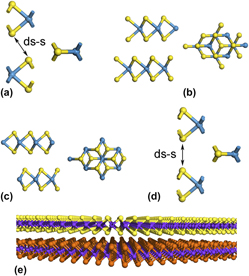Crossref Citations
This article has been cited by the following publications. This list is generated based on data provided by
Crossref.
Lv, Ruitao
Terrones, Humberto
Elías, Ana Laura
Perea-López, Néstor
Gutiérrez, Humberto R.
Cruz-Silva, Eduardo
Rajukumar, Lakshmy Pulickal
Dresselhaus, Mildred S.
and
Terrones, Mauricio
2015.
Two-dimensional transition metal dichalcogenides: Clusters, ribbons, sheets and more.
Nano Today,
Vol. 10,
Issue. 5,
p.
559.
Falmbigl, M.
Hay, Z.
Ditto, J.
Mitchson, G.
and
Johnson, D. C.
2015.
Modifying a charge density wave transition by modulation doping: ferecrystalline compounds ([Sn1−xBixSe]1.15)1(VSe2)1 with 0 ≤ x ≤ 0.66.
Journal of Materials Chemistry C,
Vol. 3,
Issue. 47,
p.
12308.
Alemayehu, Matti B.
Falmbigl, Matthias
Ta, Kim
Ditto, Jeffrey
Medlin, Douglas L.
and
Johnson, David C.
2015.
Designed Synthesis of van der Waals Heterostructures: The Power of Kinetic Control.
Angewandte Chemie International Edition,
Vol. 54,
Issue. 51,
p.
15468.
Alemayehu, Matti B.
Falmbigl, Matthias
Ta, Kim
Ditto, Jeffrey
Medlin, Douglas L.
and
Johnson, David C.
2015.
Designed Synthesis of van der Waals Heterostructures: The Power of Kinetic Control.
Angewandte Chemie,
Vol. 127,
Issue. 51,
p.
15688.
Zhang, Chendong
Chen, Yuxuan
Johnson, Amber
Li, Ming-Yang
Li, Lain-Jong
Mende, Patrick C.
Feenstra, Randall M.
and
Shih, Chih-Kang
2015.
Probing Critical Point Energies of Transition Metal Dichalcogenides: Surprising Indirect Gap of Single Layer WSe2.
Nano Letters,
Vol. 15,
Issue. 10,
p.
6494.
Gong, Yongji
Lin, Zhong
Ye, Gonglan
Shi, Gang
Feng, Simin
Lei, Yu
Elías, Ana Laura
Perea-Lopez, Nestor
Vajtai, Robert
Terrones, Humberto
Liu, Zheng
Terrones, Mauricio
and
Ajayan, Pulickel M.
2015.
Tellurium-Assisted Low-Temperature Synthesis of MoS2 and WS2 Monolayers.
ACS Nano,
Vol. 9,
Issue. 12,
p.
11658.
Niu, Tianchao
and
Li, Ang
2015.
From two-dimensional materials to heterostructures.
Progress in Surface Science,
Vol. 90,
Issue. 1,
p.
21.
Deng, Donna D.
Lin, Zhong
Elías, Ana Laura
Perea-Lopez, Nestor
Li, Jie
Zhou, Chanjing
Zhang, Kehao
Feng, Simin
Terrones, Humberto
Mayer, Jeffrey S.
Robinson, Joshua A.
Terrones, Mauricio
and
Mayer, Theresa S.
2016.
Electric-Field-Assisted Directed Assembly of Transition Metal Dichalcogenide Monolayer Sheets.
ACS Nano,
Vol. 10,
Issue. 5,
p.
5006.
Massatt, Daniel
Luskin, Mitchell
and
Ortner, Christoph
2017.
Electronic Density of States for Incommensurate Layers.
Multiscale Modeling & Simulation,
Vol. 15,
Issue. 1,
p.
476.
Wang, Xinsheng
Lin, Junhao
Zhu, Yiming
Luo, Chen
Suenaga, Kazutomo
Cai, Congzhong
and
Xie, Liming
2017.
Chemical vapor deposition of trigonal prismatic NbS2 monolayers and 3R-polytype few-layers.
Nanoscale,
Vol. 9,
Issue. 43,
p.
16607.
Luan, Chun-Yan
Xie, Shuang
Ma, Chunyan
Wang, Shengping
Kong, Yuhan
and
Xu, Mingsheng
2017.
Elucidation of luminescent mechanisms of size-controllable MoSe2 quantum dots.
Applied Physics Letters,
Vol. 111,
Issue. 7,
Cancès, Eric
Cazeaux, Paul
and
Luskin, Mitchell
2017.
Generalized Kubo formulas for the transport properties of incommensurate 2D atomic heterostructures.
Journal of Mathematical Physics,
Vol. 58,
Issue. 6,
Silva, F W N
Cruz-Silva, E
Terrones, M
Terrones, H
and
Barros, E B
2017.
BNC nanoshells: a novel structure for atomic storage.
Nanotechnology,
Vol. 28,
Issue. 46,
p.
465201.
Cazeaux, Paul
and
Luskin, Mitchell
2018.
Cauchy–Born strain energy density for coupled incommensurate elastic chains.
ESAIM: Mathematical Modelling and Numerical Analysis,
Vol. 52,
Issue. 2,
p.
729.
Costa, A L M T
Silva, F W N
and
Barros, E B
2018.
Spin polarized vertical transport in stacked TMDCs hetero-junctions.
Semiconductor Science and Technology,
Vol. 33,
Issue. 7,
p.
075018.
Lindlau, Jessica
Selig, Malte
Neumann, Andre
Colombier, Léo
Förste, Jonathan
Funk, Victor
Förg, Michael
Kim, Jonghwan
Berghäuser, Gunnar
Taniguchi, Takashi
Watanabe, Kenji
Wang, Feng
Malic, Ermin
and
Högele, Alexander
2018.
The role of momentum-dark excitons in the elementary optical response of bilayer WSe2.
Nature Communications,
Vol. 9,
Issue. 1,
Massatt, Daniel
Carr, Stephen
Luskin, Mitchell
and
Ortner, Christoph
2018.
Incommensurate Heterostructures in Momentum Space.
Multiscale Modeling & Simulation,
Vol. 16,
Issue. 1,
p.
429.
Zhou, Yuzhi
Chen, Huajie
and
Zhou, Aihui
2019.
Plane wave methods for quantum eigenvalue problems of incommensurate systems.
Journal of Computational Physics,
Vol. 384,
Issue. ,
p.
99.
Conte, Felice
Ninno, Domenico
and
Cantele, Giovanni
2019.
Electronic properties and interlayer coupling of twisted
MoS2/NbSe2
heterobilayers.
Physical Review B,
Vol. 99,
Issue. 15,
Shioya, Hiroki
Tsukagoshi, Kazuhito
Ueno, Keiji
and
Oiwa, Akira
2019.
Selective oxidation of the surface layer of bilayer WSe2 by laser heating.
Japanese Journal of Applied Physics,
Vol. 58,
Issue. 12,
p.
120903.



